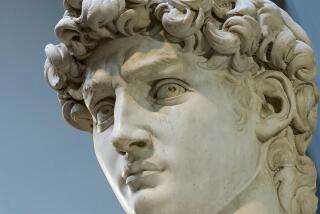Museums behaving badly: Are sanctions too little, too late?
There have been all kinds of museum shenanigans going on this week on the Right Coast. On Tuesday, the Delaware Art Museum auctioned off a painting from its collection at Christie’s so that it could pay off debt and replenish its endowment — a big no-no, since museums are only supposed to deaccession works to buy other art, not to cover operating costs. The move earned the museum sanctions from the Assn. of Art Museum Directors (AAMD), among other troubles. (My colleague Deborah Vankin has the full story here.)
Likewise, arts and architecture writer Kriston Capps has a pretty epic report in Washington’s City Paper about the Corcoran Gallery of Art, which is in the process of dissolving. The Corcoran, one of the nation’s oldest art institutions, has had a slew of financial problems in recent years due to lackluster fundraising and other administrative issues. The museum’s building and its collections (though not necessarily its staff) will now be absorbed by the National Gallery and George Washington University.
To revise its federal charter, the Corcoran had to file a petition with the Superior Court in the District of Columbia, which Capps combs to spectacular effect. (Seriously, read his piece, which picks apart the trustees’ rather mealy mouthed statements, complete with Jennifer Lawrence reaction GIF.) Among other issues, he notes that the Corcoran deaccessioned various priceless rugs at Sotheby’s last year, even as it was devising its own death. The move didn’t earn it sanctions, but it is pretty weird.
Certainly, there have been plenty of stories like this over the years. A lot of museums — like the American Folk Art Museum in New York — got into trouble with massive building campaigns during the boom years, only to suffer the consequences later when the economy hit the skids and fund-raising ground to halt. And then there were others that just spent down their endowment because, you know, what the hey. (I’m lookin’ at you, 2008-era MOCA.)
A lot of this raises the question of whether things like AAMD sanctions are simply too little, too late. Sure, it’s important that the association not stand idly by as museums pawn off works held in a public trust — especially since many of those works are bound to land in private hands when museums auction them off. (The Delaware Art Museum painting, William Holman Hunt’s “Isabella and the Pot of Basil,” went to an unidentified buyer.)
But I have to wonder how effective sanctions have been. As culture blogger Lee Rosenbaum points out, the AAMD sanctioned the National Academy Museum in New York after that institution sold off two important Hudson River School paintings in 2008 to pay the bills. Two years later it lifted the sanctions. The museum is still in fragile condition. And, as far as I can tell, the paintings, bought by an unidentified buyer, haven’t been seen since. So what exactly did the sanctions achieve?
Rosenbaum suggests that a better idea would be for the AAMD to support legislation that would prevent museums from dipping into their collections to cover operating budgets. So far, New York is the only state to have such laws on the books.
But Christine Anagnos, executive director of the AAMD, told me via email that that is not in the cards. “The development of legislation is for legislators to consider,” she wrote. “Non-profits such as museums are already governed by many laws, at both the state and federal level. Where an issue as complex and specific as deaccessioning is concerned, our view is that the professional standards of the art museum field are best established and reinforced by those working in the field.”
Certainly, trying to get anything through Congress these days is a long shot. And I’m wary of anything that hamstrings cultural institutions with more rules. But with major public art collections hanging in the balance (think: Detroit Institute of Arts), it might be worth considering ideas that go beyond sanctions.
In the case of the Corcoran, the collection will remain public, since it is being absorbed through the National Gallery. But other floundering museums may not be so lucky, and may simply be desperate to sell. It would be a shame for all that art, now available to the public, to end up in some mogul’s oceanside McMansion, visible only to a chosen few over cocktails and cigars.
Twitter: @cmonstah
More to Read
The biggest entertainment stories
Get our big stories about Hollywood, film, television, music, arts, culture and more right in your inbox as soon as they publish.
You may occasionally receive promotional content from the Los Angeles Times.











